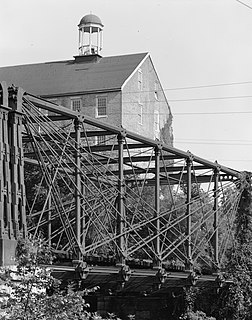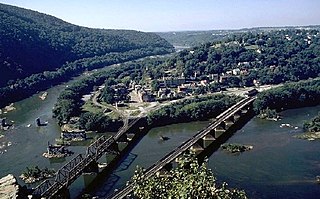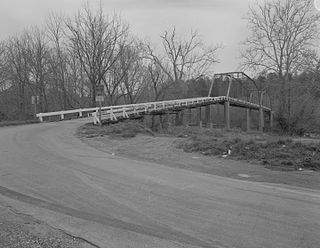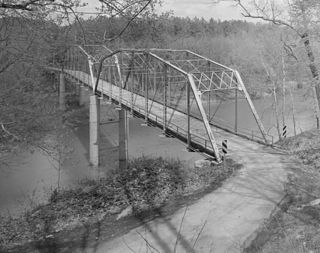
The Humpback Covered Bridge located in the U.S. state of Virginia, is one of the few remaining covered bridges in the United States that was built higher in the middle than on either end; hence the name of "humpback". The bridge was built in 1857 and is also the oldest remaining covered bridge in the state of Virginia. Its WGCB number is 46-03-01. The bridge spans a tributary of the Jackson River known as Dunlap Creek, for a distance of 109 feet (33 m). The humpback feature is 4 feet (1.2 m) higher in the center than at either end. The bridge is located near the city of Covington, Virginia.

The Laughery Creek Bridge is a triple whipple truss bridge on the border of Dearborn County, Indiana, and Ohio County, Indiana. It crosses Laughery Creek. This bridge was built in 1878. The Wrought Iron Bridge Company, a prolific late 19th-century bridge company, constructed the bridge. The bridge is seated on stone abutments. The deck surface is not original and is currently concrete. The bridge, nearly 300 feet in length, is a single span pin connected triple intersection Whipple through truss, and is the only example in the world of this truss type. The name bridge's nickname, "Triple Whipple Bridge" is a play on words. The double-intersection Pratt, which was called the Whipple truss configuration, was a far more common variation of the standard Pratt configuration. Since the Laughery Creek Bridge's members have three intersections instead of two, this gives rise to the "Triple Whipple" name. This bridge was listed on the National Register of Historic Places in 1976.

The Bollman Truss Railroad Bridge at Savage, Maryland is the sole surviving example of a revolutionary design in the history of American bridge engineering. The 160-foot (48.8 m) double-span is a suspension truss bridge. The first Bollman bridge was installed on the site; however, the current bridge is not the original. The current bridge was built in 1852 and moved to the site thirty years later. It is one of the oldest standing iron railroad bridges in the United States. Currently, however, it is in use carrying the Savage Mill Trail across the Little Patuxent River.

The Parkersburg Bridge crosses the Ohio River between Parkersburg, West Virginia, and Belpre, Ohio. Designed by Jacob Linville, the bridge has 46 spans: 25 deck plate girder, 14 deck truss, 6 through truss, and 1 through plate girder. 50,000 cubic yards (38,000 m3) of stone were used for the 53 piers. The bridge was constructed from May 1869 to January 1871 by the Baltimore and Ohio Railroad. At the time of its completion, the bridge was reportedly the longest in the world at 7,140 feet (2,180 m).

The Casselman Bridge is an historic transportation structure on the Casselman River, located immediately east of Grantsville in Garrett County, Maryland. The bridge was built in 1813-1814 as part of the National Road. Historic markers posted at each end read:
Erected 1813 by David Shriver, Jr.,
Sup't of the "Cumberland Road". This 80 foot span
was the largest stone arch in America
at the time. It was continuously
used from 1813 to 1933.

The B & O Railroad Potomac River Crossing is a 15-acre (6.1 ha) historic site where a set of railroad bridges, originally built by the Baltimore and Ohio Railroad, span the Potomac River between Sandy Hook, Maryland, and Harpers Ferry, West Virginia, in the United States. The site was added to the National Register of Historic Places on February 14, 1978 for its significance in commerce, engineering, industry, invention, and transportation.

The Catoctin Creek Bridge crosses over Catoctin Creek in Loudoun County, Virginia.

Valley Railroad Stone Bridge is a historic stone arch bridge spanning Folly Mills Creek near Jolivue, Augusta County, Virginia. It was built in 1874 by the Valley Railroad, and is a four-span structure with an overall length of 130 feet (40 m) and a width of 15 feet (4.6 m). It is constructed of granite and faced in ashlar and features semi-circular arches set on gently splayed piers. It was acquired by the Virginia Department of Transportation in 1965. It is considered a scenic landmark along Interstate 81.

Buchanan Historic District is a national historic district located at Buchanan, Botetourt County, Virginia. It encompasses 277 contributing buildings, 5 contributing sites, and 4 contributing structures in Buchanan and Pattonsburg on both sides of the James River. They include commercial, transportation-related, domestic, religious, and industrial resources associated with the community's development from the late-18th century through the late-20th century. Notable buildings include the Pattonsburg Mill (1838), Buchanan Presbyterian Church (1845), Trinity Episcopal Church (1842), Hotel Botetourt (1851), Sorrell House (1850), James Evans Mason Lodge (1884), Virginia Can Company complex (1903), "Oak Hill" (1840), Town Hall Municipal Building, Bank of Buchanan, Ransone's Drugstore, Buchanan Theatre (1919), and Buchanan High School (1928). The contributing sites include the James River & Kanawha Canal project site, Johnston-Boyd Cemetery (1835–1906), and Mountain View Cemetery (1854). The contributing structures include the Stone Arch Tunnel (1870s). Also located in the district is the separately listed Wilson Warehouse.

Phoenix Bridge is a historic metal Trapezoidal Whipple truss railroad bridge spanning Craig Creek near Eagle Rock, Botetourt County, Virginia. It was built in 1887 by the Phoenix Bridge Company of Phoenixville, Pennsylvania. It consists of rolled wrought-iron "Phoenix post" compression members and round and rectangular tension rods with pinned joints. It includes a cast panel embellished with anthemions and garlands, small urnlike finials, and quatrefoils and trefoils.

Gholson Bridge is a historic metal Pratt truss bridge spanning the Meherrin River near Lawrenceville, Brunswick County, Virginia. It was built in 1884 by the Wrought Iron Bridge Company. It consists of two spans. One span is 84 feet (26 m) long and the second is 100 feet 4 inches (30.58 m). It sits on an ashlar sandstone substructure.

Mansion Truss Bridge was a historic Camelback through truss bridge located near Mansion(now Altavista) in Campbell County, Virginia. It was built in 1903, and consisted of two camelback through trusses. It was elevated high above the Staunton River and took its name from the 18th century mansion of early settler John Ward.

Clarkton Bridge was a historic Pratt truss bridge located over the Staunton River near Nathalie, in Charlotte County, Virginia. It was built in 1902 by the Virginia Bridge & Iron Co., and was the only remaining metal truss structure in Virginia built for highway purposes, which was supported by steel cylinder piers. It consisted of two camelback, pin-connected steel through truss channel spans, and twelve steel deck beam approach spans. The overall dimensions of the bridge approach and truss spans were as follows: north approach, 370 feet (110 m) with twelve deck spans; north truss, 150 feet (46 m); south truss, 150 feet (46 m). The total length of the bridge was 692 feet (211 m).

Meems Bottom Covered Bridge is a covered bridge in Shenandoah County, Virginia, United States. The bridge, at 204 feet (62 m), is the longest covered bridge in Virginia and one of the last that supports regular traffic. Near the town of Mount Jackson, the Meems Bottom Covered Bridge features a 200-foot single-span wooden Burr arch structure. Built in 1892 by Franklin Hiser Wissler, the wooden bridge over the North Fork of the Shenandoah River provided access to his apple orchards at Strathmore Farms. The bridge was listed on the National Register of Historic Places on June 10, 1975.

Bowstring Truss Bridge, also known as the Roaring Run Bowstring Truss Bridge and King Tubular Arch Truss Bridge, is a historic bowstring truss bridge located at the Ironto Rest Area near Ironto, Montgomery County, Virginia. It was built by the King Bridge Company in 1878, and is a single-span, four-panel tubular arch pony truss. It measures 55 feet (17 m) long, 12 feet (3.7 m) wide, and 6 feet 6 inches (1.98 m) high with an open roadway width of approximately 9 feet 6 inches (2.90 m). The bridge was partially disassembled and moved from its original location to a second site during the 1930s, where it remained until moved to its current location in 1977.

Oak Ridge Railroad Overpass is a historic Pratt truss bridge located near Shipman, Nelson County, Virginia. It was built by the Keystone Bridge Company in 1882, and is a single-span, through Pratt truss with two wooden beam approach spans. The span length is 100 feet (30 m). The approach spans are 19 feet (5.8 m) long. It carries VA State Route 653 over the busy Norfolk Southern Washington District, part of the former Southern Main Line between Washington, D.C. and Atlanta.

Page County Bridge No. 1990, also known as Overall Bridge, is a historic Pratt deck arch truss bridge located at Overall, Page County, Virginia. It was built in 1938, and is a single-span Pratt deck arch metal truss bridge with four "T"-beam concrete approach spans. It is approximately 123 feet long and the entire bridge length is approximately 245 feet.

Nokesville Truss Bridge is a historic Pratt truss bridge spanning the Norfolk Southern Railway near Nokesville, Prince William County, Virginia. It was built in 1882 by the Keystone Bridge Company. The single-span bridge measures 73 feet 11.5 inches (22.543 m) long, and is constructed of wrought iron.

Goshen Land Company Bridge is a historic Pratt through truss bridge spanning the Calfpasture River near Goshen, in Rockbridge County, Virginia, United States. Built in 1890 by the Groton Bridge Company, it consists of two spans, one measuring 138 feet 10 inches (42.32 m) long and the second measuring 120 feet 10 inches (36.83 m); both spans sit at a 30-degree skew.

Linville Creek Bridge is a historic Thacher truss bridge located near Broadway, Rockingham County, Virginia. It was built by the Wrought Iron Bridge Company in 1898. It is a single span, measuring 135 feet 11 inches (41.43 m) long. This bridge was formerly identified as a hybrid Whipple, incorporating aspects of both the double-intersection Pratt and the double-intersection Warren. The structure in actuality is a Thacher truss, a hybrid configuration incorporating elements of the Pratt, Warren, Fink, and Bollman trusses that was first patented by Edwin Thacher in 1883. Its unusual configuration and the bewildering number of descriptions that have been applied to it merely reinforce its position as a bridge that is a rare survivor of an uncommon form.
























